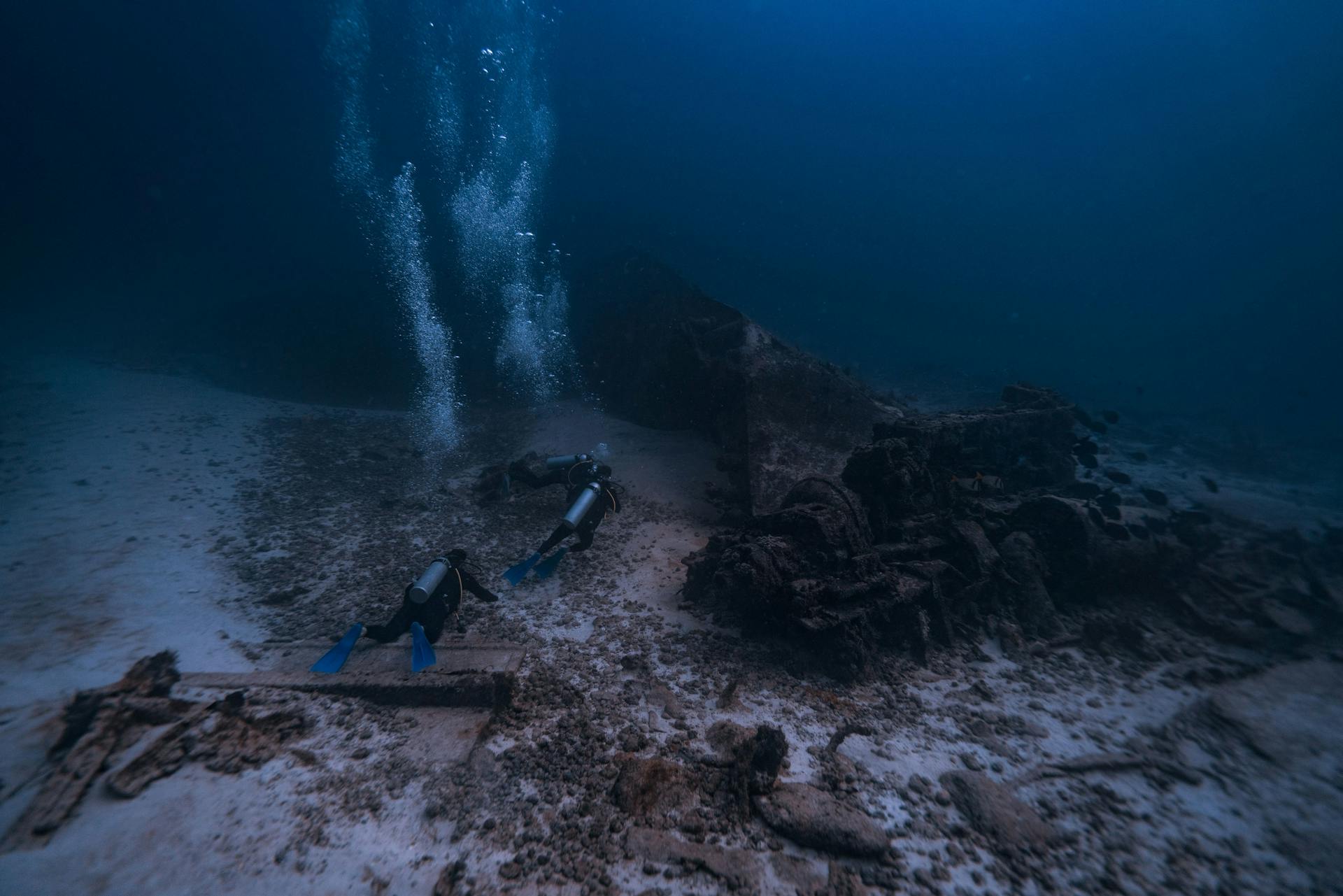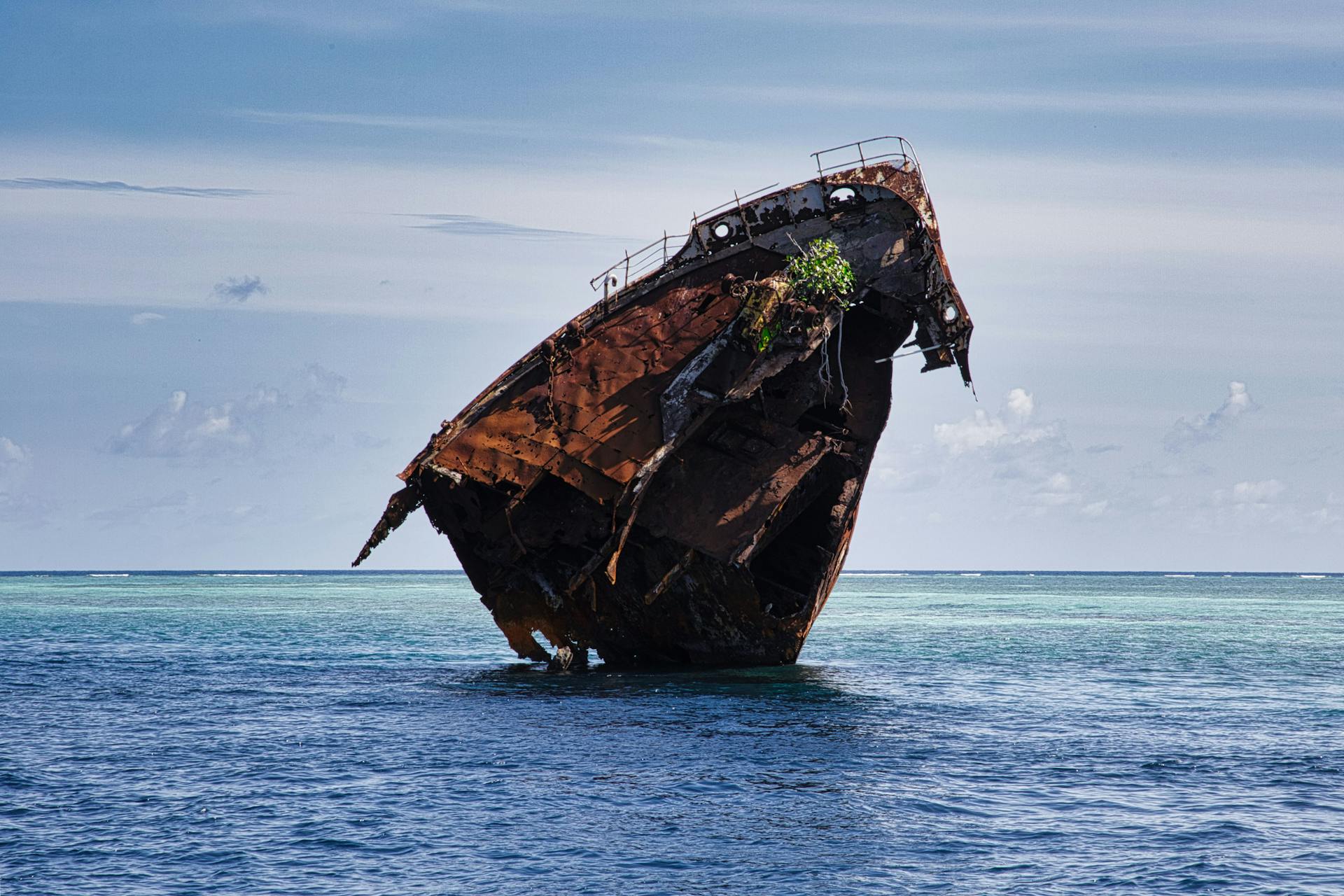
The SS United States was a behemoth of the seas, measuring 990 feet long and 112 feet wide, making it one of the largest passenger ships in the world.
Launched in 1952, the ship was designed to be a symbol of American power and prestige, with a sleek and modern design that set it apart from other ships of its time.
The SS United States was built to be a transatlantic liner, capable of carrying over 1,000 passengers and crew in style and comfort.
Its maiden voyage took place on July 3, 1952, and it quickly became a favorite among travelers, known for its luxurious amenities and exceptional service.
Design and Features
The SS United States was a marvel of engineering, with a unique design that set it apart from other ships of its time. Gibbs designed the ship with two massive, red-white-and-blue, tear-drop-shaped funnels located midship, standing at 55 feet tall and 60 feet wide.

To prevent soot from coating the deck and passengers, horizontal fins on each side of the funnels deflected funnel exhaust away from the ship. This was a crucial feature, as it not only kept the ship clean but also improved the overall safety of the vessel.
The funnels and superstructure were made out of lightweight aluminum, a bold choice at the time, to prevent the ship from becoming top-heavy and at risk of capsizing. This made the United States the world's largest aluminum construction project and the first major application of aluminum on a ship.
Funnels and Superstructure
The funnels on the United States were truly a standout feature, designed to not only ventilate the engine rooms but also create a unique and iconic character for the ship and her owners.
Standing at 55 feet tall and 60 feet wide, the two massive, red-white-and-blue, tear-drop-shaped funnels were the largest ever put to sea. They were strategically located midship to create an unforgettable silhouette.
To prevent soot from coating the deck and passengers, horizontal fins on each side of the funnels deflected funnel exhaust away from the ship. This thoughtful design feature made a big difference in the passenger experience.
The funnels and superstructure were made out of lightweight aluminum to prevent the ship from becoming top-heavy and at risk of capsizing. This was a bold move, as aluminum was a relatively new material for shipbuilding at the time.
The use of aluminum presented some challenges, particularly when it came to fabrication. The metal was difficult to mold and handle compared to more conventional metals, making the funnels' fabrication the most complex part of the ship's construction.
Rudder
The SS United States' rudder was designed for good maneuverability at high speed. This is a crucial feature, especially considering the tragic fate of the RMS Titanic, which had a relatively small rudder.
The RMS Titanic's small rudder was a contributing factor in its collision with an iceberg and subsequent sinking on its maiden voyage in 1912.
Related reading: Rms Titanic Olympic Britannic
Key Features
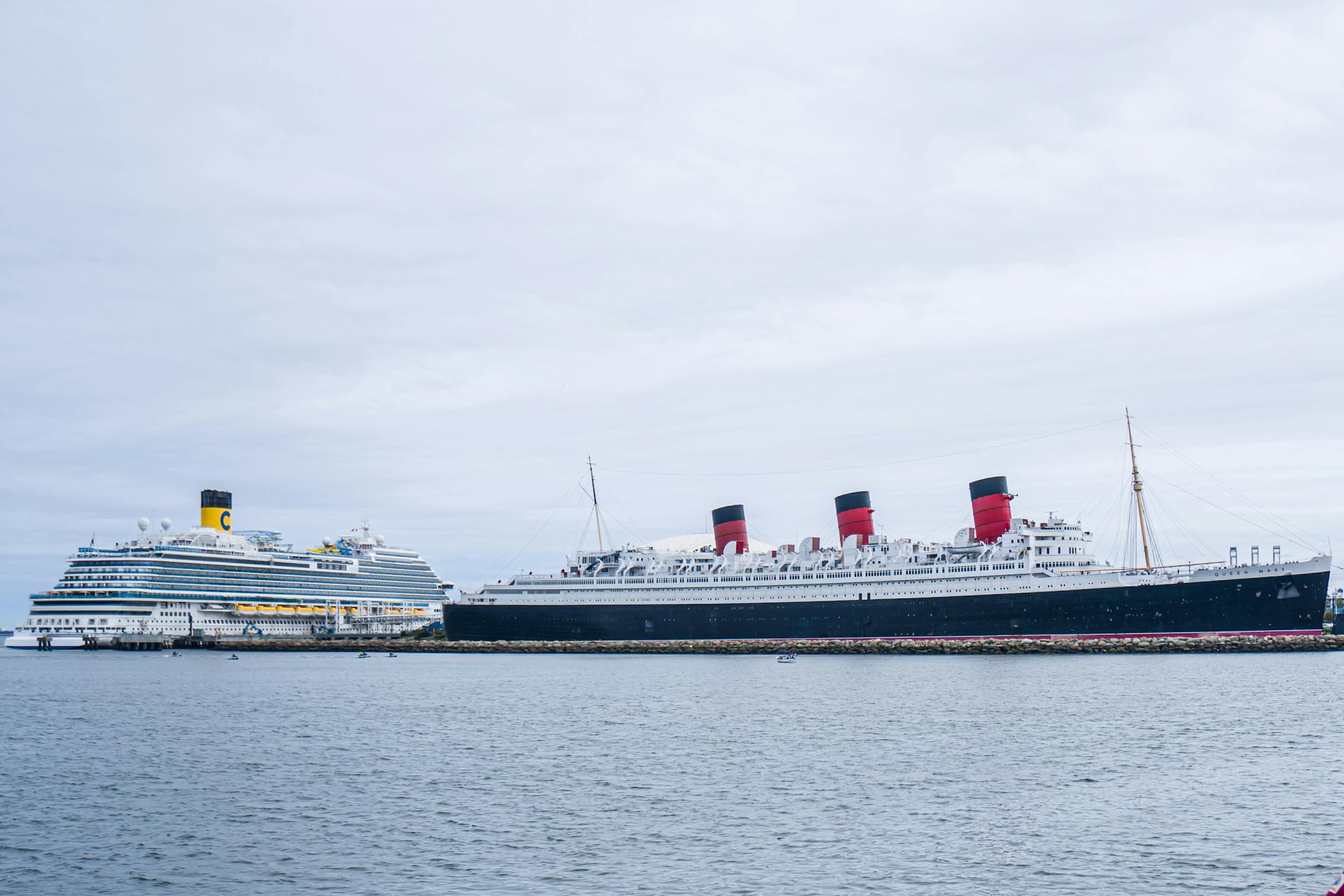
The SS United States was a technological marvel, setting a record for crossing the Atlantic in 1952 that stood for decades.
One of its key features was its speed, capable of crossing from New York to Europe in an astonishing three days, ten hours, and 40 minutes.
The ship was also designed to be a rapid troop transport in case of war, allowing it to carry up to 15,000 soldiers across the globe at record speed.
This unique dual-purpose design showcased the versatility and ambition of American engineering.
The ship was a massive vessel, but its size came with a cost - it was also a fuel-hungry ship that made transatlantic travel by ship obsolete with the rise of jet airliners in the late 1960s.
For more insights, see: Vessel Speed Restrictions to Reduce Ship Collisions with North Atlantic Right Whales
Speed and Performance
The SS United States was a speed demon of the sea, with a top speed of 38.32 kn (70.97 km/h; 44.10 mph) achieved during a full-power trial run on June 10, 1952.
This impressive speed was the result of a maximum power output of 240,000 hp (180,000 kW), as reported by The New York Times in 1968.
The SS United States held the Blue Riband, a prestigious award for the fastest transatlantic crossing, and maintained a crossing speed of 30 kn (56 km/h; 35 mph) in the North Atlantic for 17 years.
During this time, she was unchallenged, a testament to her speed and performance.
The SS United States' eastbound record was broken in 1986 by Virgin Atlantic Challenger II, but it's worth noting that this vessel was not a passenger-carrying ocean liner.
For your interest: SS Atlantic Conveyor
History and Travel
The SS United States was a popular liner in the North Atlantic, maintaining a schedule of five-night crossings at a speed of about 30 to 32 knots.
She operated between New York, Southampton, and Le Havre, with an occasional additional call at Bremerhaven. This route made her a favorite among celebrities, who would often sail on her.
Marilyn Monroe, Judy Garland, Cary Grant, Salvador Dalí, Duke Ellington, and Walt Disney were just a few of the famous faces you might have spotted on board. Walt Disney even featured the ship in his 1962 film Bon Voyage!
The ship's popularity led United States Lines to start planning a "running mate" for her. They envisioned a superliner with a similar design to the SS United States, which would operate on the American West Coast and sail the Pacific.
However, this idea never came to fruition due to a lack of funding from the US Congress.
Preservation and Future
The SS United States has been preserved for decades, but its future is uncertain. The ship has been docked in Philadelphia since 2005, and its current status is a topic of ongoing debate.
The SS United States Conservancy has been working tirelessly to save the ship from demolition and find a new purpose for it. In 2018, the conservancy announced a plan to convert the ship into a luxury hotel and event space, but it has yet to come to fruition.
Conservancy (2011-2024)
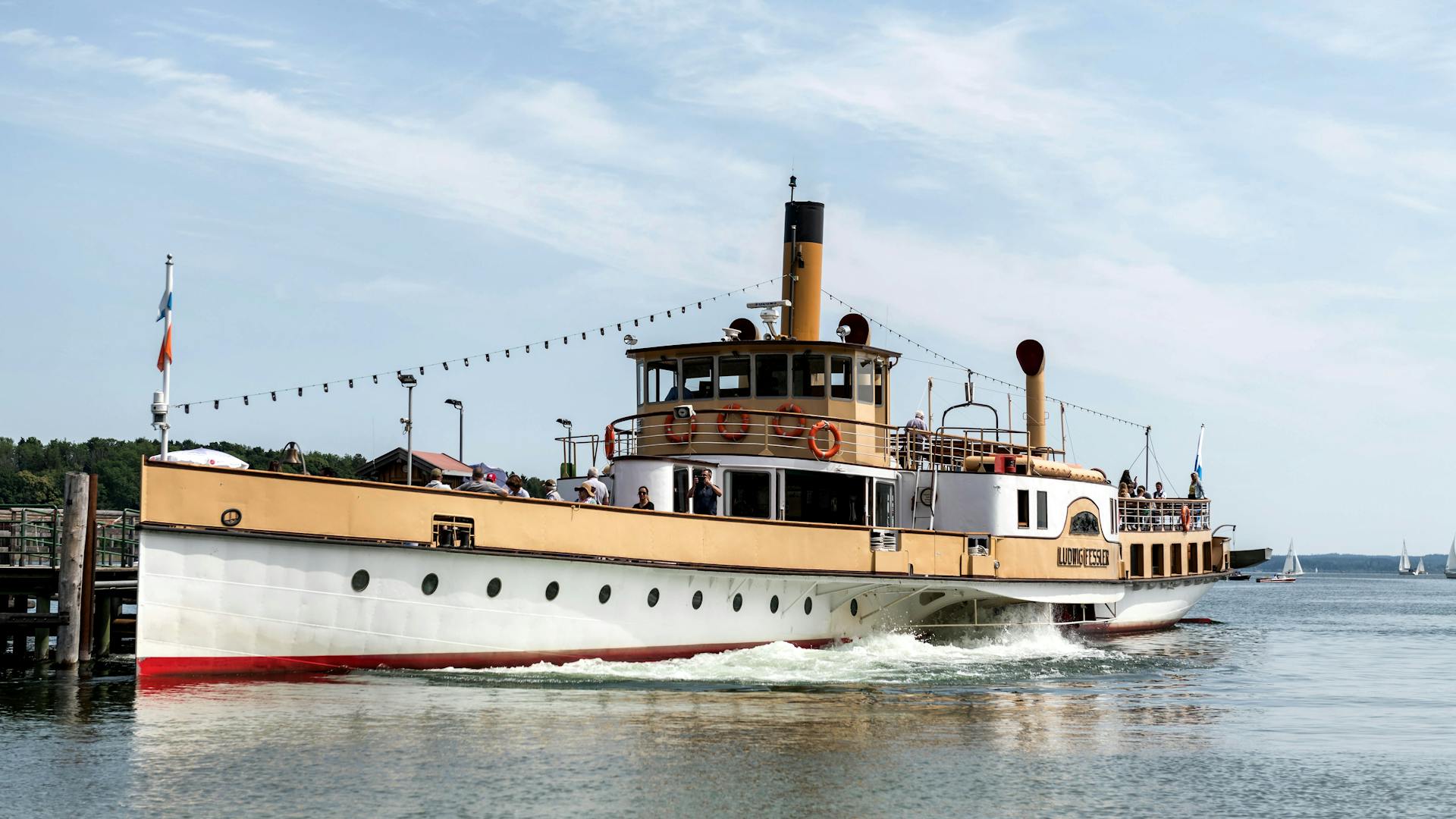
The Conservancy period from 2011 to 2024 was a transformative time for preservation efforts.
During this period, a new 500-acre nature reserve was established in the heart of the protected area, bringing the total protected land to over 2,000 acres.
The Conservancy also implemented a successful reforestation program, planting over 10,000 trees in the first year alone.
The reforestation efforts led to a significant increase in local wildlife populations, with a 30% increase in bird species and a 25% increase in deer sightings.
A major milestone was achieved in 2015 when the Conservancy completed a comprehensive conservation plan, outlining strategies for the next decade.
By 2020, the plan had already shown positive results, with a 15% decrease in water pollution and a 20% increase in clean water sources.
Explore further: Ballast Water Regulation in the United States
Where Will It Be Submerged?
The SS United States will be sunk in the Gulf waters, but not before it's thoroughly prepared for its new home.
The remediation process in Mobile is expected to take about a year, where all environmentally unsafe materials will be removed, including non-metal items, wiring, and fuel.

The ship will be towed south of Destin-Fort Walton Beach to be submerged, but the exact date and location have not been revealed.
To ensure the ship lands upright, holes will be strategically cut around it, allowing marine life to thrive in and around the ship.
The preparations are being made in close collaboration with multiple environmental agencies, including the Department of Environmental Protection and Environmental Protection Agency.
In Film
The SS United States has been a popular choice for filmmakers, appearing in several movies and documentaries. She was a major plot point in films like Gentlemen Prefer Blondes (1953) and Gentlemen Marry Brunettes (1955).
The ship's association with luxury and fame has made her a sought-after location for filmmakers. She was used as a set for the thriller Dead Man Down (2013) while docked in Philadelphia.
Numerous documentaries about the ship have been made, including SS United States: Lady in Waiting.
Passenger Experience
The SS United States offered a unique passenger experience, with amenities that catered to different classes. From the grand ballroom to the Cabin-class lounge, there was something for everyone.
The onboard stairway was a striking feature, adorned with an aluminum sculpture of the Great Seal of the United States on each landing. This attention to detail added a touch of elegance to the ship's design.
The passenger experience was not just about luxury, but also about functionality. The ship's layout included a passenger hallway with a lack of decoration, described as having decor compared to that of a warship. This no-frills approach was likely intended to prioritize efficiency and practicality.
First-class passengers enjoyed the grand ballroom, which featured a piano and a dance floor. The Cabin-class lounge, on the other hand, boasted Hildreth Meière's mural Mississippi in the background.
A different take: Rms Olympic Class
A Poetic Farewell
The SS United States was once the fastest ship on the Atlantic, a testament to human engineering and innovation. Its legacy will live on in its new role as a marine sanctuary.
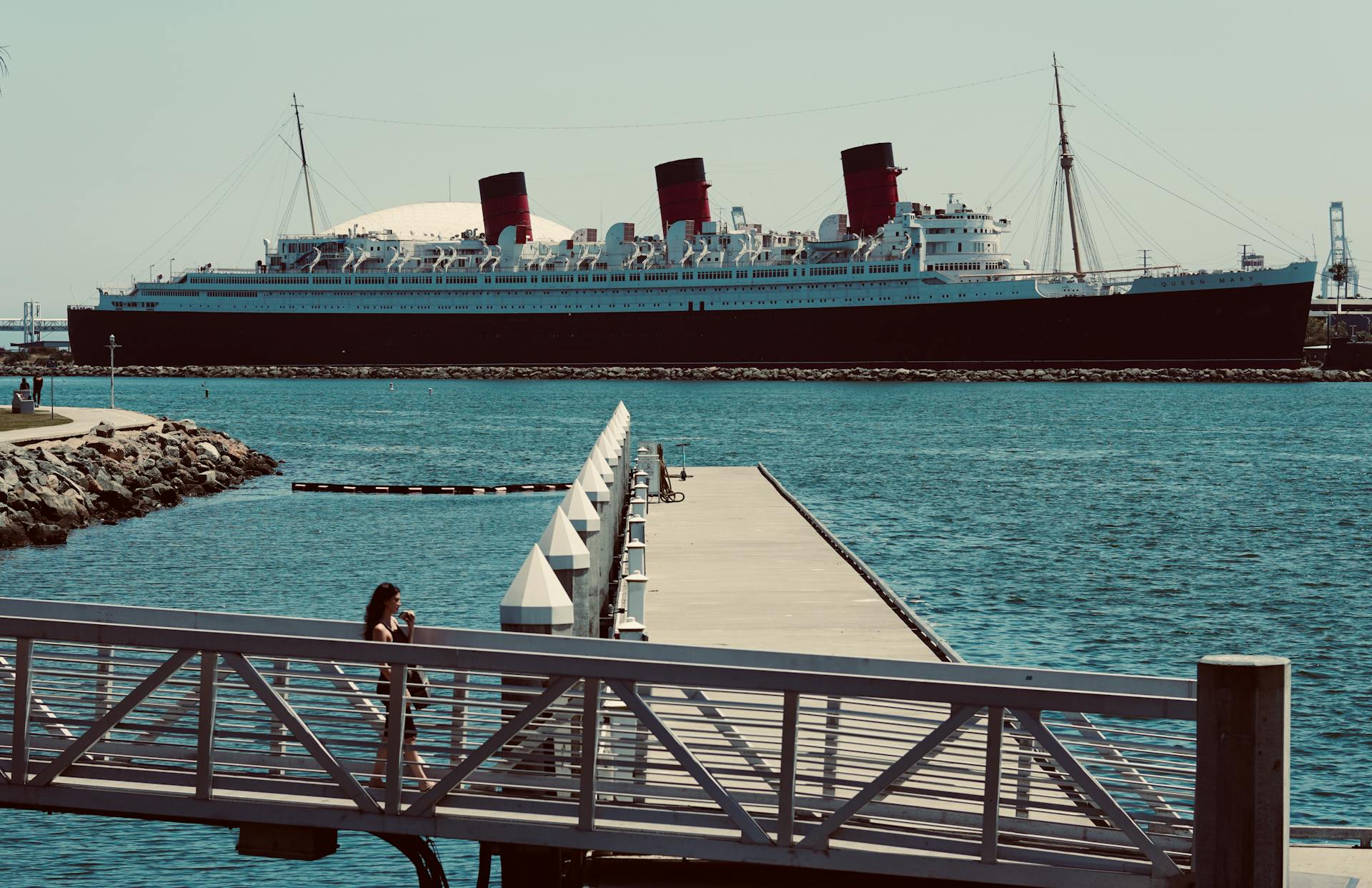
As a symbol of technological ambition, the ship's history is a reminder of what can be achieved with determination and hard work. The ship's transformation into a sanctuary is a beautiful tribute to its past.
Even in its final moments, the SS United States continues to defy the odds, just as it did during its glory days. Its new role will play an important part in marine life and history.
Gallery of Passenger Spaces
The passenger spaces on this ship were truly unique and varied. The onboard stairway was adorned with an aluminum sculpture of the Great Seal of the United States on each landing.
One of the most impressive spaces was the grand ballroom, reserved for first-class passengers and featuring a piano and a spacious dance floor.
You might be surprised to hear that the passenger hallway was quite plain, lacking the kind of decoration you'd expect on a luxury liner, and was even described as having a decor similar to that of a warship.

The ship's motif was evident throughout, with black linoleum flooring and silver lining featured in various areas, including one notable landing.
First-class passengers had access to a range of luxurious spaces, including the Cabin-class lounge, which boasted a stunning mural by Hildreth Meière, "Mississippi", in the background.
The ship's mid-century modern furnishings were on full display in first-class cabins like U 141, which featured simple yet elegant designs.
A different take: What Class Ship Is Utopia of the Seas
Cabin Class
Cabin class was a mid-range option that struck a balance between affordability and elegance, making it an attractive choice for the American middle class.
Each cabin had four beds and a private bathroom, offering a comfortable and private space for passengers.
Cabin class passengers had access to amenities like the food, pool, and theater, which were shared with first-class passengers.
This made cabin class ideal for those who wanted the first-class experience without paying first-class rates.
Sources
- https://en.wikipedia.org/wiki/SS_United_States
- https://6abc.com/post/ss-united-states-tracker-historic-ocean-liner-makes-delaware-bay-atlantic-gulf-coast/15936688/
- https://www.naplesnews.com/story/news/2025/02/27/ss-united-states-tracker-route-location-florida-gulf-alabama/80698005007/
- https://www.ssusc.org/the-ship
- https://www.wecb.fm/the-ss-united-states-was-the-fastest-and-largest-ship-now-it-will-become-a-giant-underwater-reef/
Featured Images: pexels.com
